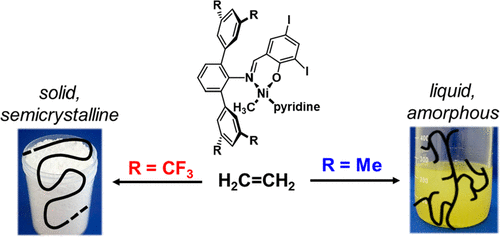当前位置:
X-MOL 学术
›
Acc. Chem. Res.
›
论文详情
Our official English website, www.x-mol.net, welcomes your
feedback! (Note: you will need to create a separate account there.)
Neutral Nickel(II) Catalysts: From Hyperbranched Oligomers to Nanocrystal-Based Materials
Accounts of Chemical Research ( IF 16.4 ) Pub Date : 2020-10-23 , DOI: 10.1021/acs.accounts.0c00540 Stefan Mecking 1 , Manuel Schnitte 1
Accounts of Chemical Research ( IF 16.4 ) Pub Date : 2020-10-23 , DOI: 10.1021/acs.accounts.0c00540 Stefan Mecking 1 , Manuel Schnitte 1
Affiliation

|
Plastics materials are a vital component of modern technologies. They are applied, e.g., in construction, transportation, communication, water supply, or health care. Consequently, polyolefins–the most important plastics by scale–are produced in vast amounts by catalytic polymerization. Effective and selective as the catalysts used may be, their high sensitivity toward any polar compounds limits these methods to hydrocarbon reaction media and monomers like ethylene and propylene, respectively. This can be overcome by less oxophilic late transition metal catalysts, and here particularly neutral nickel(II) catalysts have seen major advances in the past few years. They stand out due to being capable of aqueous catalytic polymerizations. Aqueous polymerizations are benign processes that advantageously yield polymers in the form of particles. Moreover, these catalysts can incorporate polar monomers like acrylates, a realm previously restricted to noble metal catalysts. The introduction of polar moieties can induce properties like compatibility with metals or fibers in high performance composite materials or a desirable degradability.
中文翻译:

中性镍(II)催化剂:从超支化低聚物到纳米晶体基材料
塑料材料是现代技术的重要组成部分。它们被应用于例如建筑,运输,通讯,供水或医疗保健中。因此,聚烯烃(按比例计最重要的塑料)是通过催化聚合大量生产的。由于使用的催化剂可能有效且具有选择性,它们对任何极性化合物的高灵敏度都将这些方法分别限制于烃反应介质和单体,如乙烯和丙烯。这可以通过减少亲氧性的后期过渡金属催化剂来克服,特别是中性镍(II)催化剂在过去几年中取得了重大进展。它们由于能够进行水性催化聚合而脱颖而出。水性聚合是有益的方法,其有利地产生颗粒形式的聚合物。此外,这些催化剂可以掺入极性单体,如丙烯酸酯,以前仅限于贵金属催化剂。极性部分的引入可以引起诸如在高性能复合材料中与金属或纤维的相容性或期望的降解性之类的性质。
更新日期:2020-11-17
中文翻译:

中性镍(II)催化剂:从超支化低聚物到纳米晶体基材料
塑料材料是现代技术的重要组成部分。它们被应用于例如建筑,运输,通讯,供水或医疗保健中。因此,聚烯烃(按比例计最重要的塑料)是通过催化聚合大量生产的。由于使用的催化剂可能有效且具有选择性,它们对任何极性化合物的高灵敏度都将这些方法分别限制于烃反应介质和单体,如乙烯和丙烯。这可以通过减少亲氧性的后期过渡金属催化剂来克服,特别是中性镍(II)催化剂在过去几年中取得了重大进展。它们由于能够进行水性催化聚合而脱颖而出。水性聚合是有益的方法,其有利地产生颗粒形式的聚合物。此外,这些催化剂可以掺入极性单体,如丙烯酸酯,以前仅限于贵金属催化剂。极性部分的引入可以引起诸如在高性能复合材料中与金属或纤维的相容性或期望的降解性之类的性质。










































 京公网安备 11010802027423号
京公网安备 11010802027423号